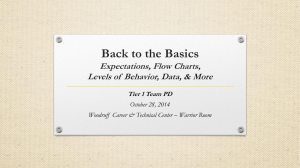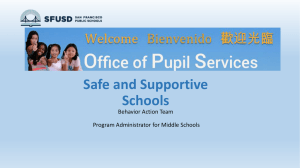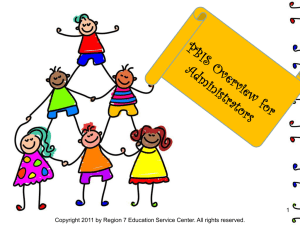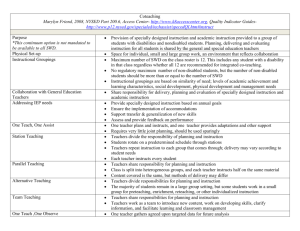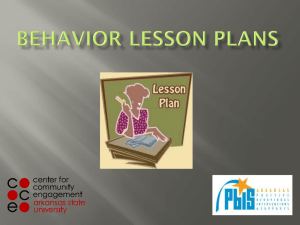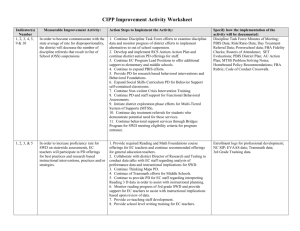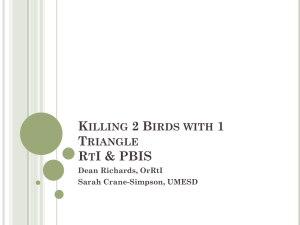PowerPoint - Wisconsin PBIS Network
advertisement
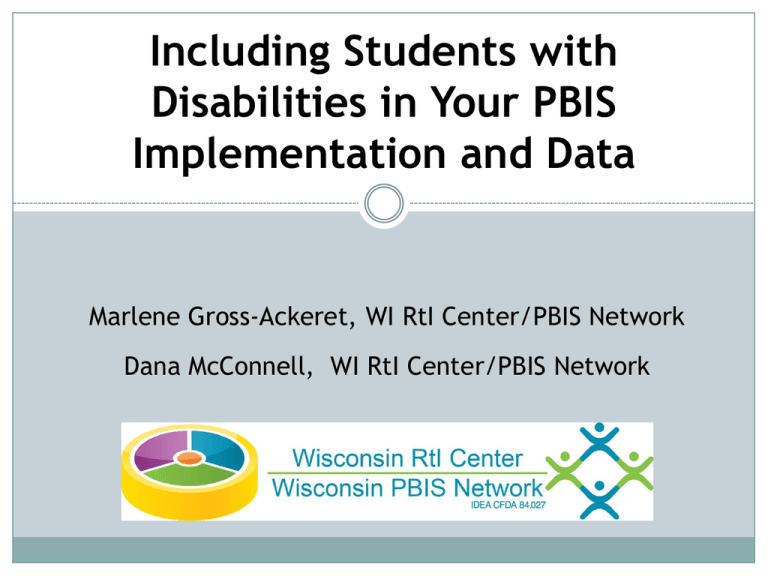
Including Students with Disabilities in Your PBIS Implementation and Data Marlene Gross-Ackeret, WI RtI Center/PBIS Network Dana McConnell, WI RtI Center/PBIS Network Agenda Introductions Outcomes for the day PBIS Overview Principles behind PBIS Make connection to SwD Data How are you collecting data? Looking at data? Using Data? What are you missing? APBS Info on History Practices Systems view For ALL Belief System/Culture District level support structures UDL Review the Principles of UDL Link to CRP & increase in engagement Link connections to PBIS Next Steps…….. Outcomes for the Session History of PBIS as it connects to SwD Research and rationale Reflection on current practices Understanding of benefits for ALL students and staff Strategies to meet the diverse needs of our students Next steps in moving forward We Know……. To improve the academic success of our children, we must also improve their social success. Academic and social failures are reciprocally and inextricably related. “Viewed as outcomes, achievement and behavior are related; viewed as causes of each other, achievement and behavior are unrelated. In this context, teaching behavior as relentlessly as we teach reading or other academic content is the ultimate act of prevention, promise, and power underlying PBIS and other preventive interventions in America’s schools.” Algozzine, Wang, & Violette (2011, p. 16) What do we know about school discipline referrals and SWD? Students with disabilities tend to be over- represented in school discipline (Cooley, 1995, Fabelo et al., 2011; Kresmien, Leone, & Achilles, 2006; Rausch % Skiba, 2006; SRI International, 2006; Zhang, Katsiyannus, & Herbst, 2004). Educational Outcomes for Students w/Disabilities Students w/disabilities are almost 2X as likely to be suspended from school as nondisabled students, with the highest rates among black children with disabilities. 13% of students w/ disabilities in kindergarten through 12th grade were suspended during the 2009-10 school year, compared to 7% of students without disabilities. Among black children with disabilities, the rate was much higher: one out of four were suspended at least once that school year. Department of Ed.; The New York Times, August 7, 2012 Educational Outcomes for Students with EBD 40-60% drop out of high school (Wagner, 1991, 1996; Wagner, Kutash, Duchnowski, & Epstein, 2005) Experience poorer academic performance than Students with SLD (Lane, Carter, Pierson & Glaeser, 2006) 10-25% enroll in post-secondary education (compared to 53% of typical population) (Bullis & Cheney, 1999) High rated if unemployment/underemployment postschool (Bullis & Cheney, 1999; Kortering, Hess & Braziel, 1996, Wagner 1991; Wehman, 1996) High rates of MH challenges, poverty, incarceration (Alexander, et al., 1997; Kortering, et al., Lee and Burkham, 1992, Wagner 1992) Youth with EBD . . . Disengaged from school/family/community Most likely disability group to be educated in a segregated setting Highest rates of disciplinary infractions Perceived by teachers as having significantly lower levels of social competence and school adjustment (Lane, Carter, Pierson, & Glaeser, 2006) Historical Development of PBIS During the 1980s, a need was identified for improved selection, implementation, and documentation of effective behavioral interventions for students with EBD. (Greshan, 1991; Sugai & Horner, 1999; Walker et al., 1996) Researchers at the University of Oregon began a series of applied demonstrations, research studies, and evaluation projects. Results: greater attention directed toward prevention, research-based practices, data-based decision making, school-wide systems, explicit social skills instruction, teambased implementation and professional development. (Sugai & Horner, 2002; Horner, Sugai, Anderson, 2010) Historical Development of PBIS cont’d Reauthorization of IDEA in 1997 - grant to establish Center on Positive Behavioral Interventions and Supports to disseminate and provide technical assistance to schools on evidence based practices for improving supports for students with EBD. PBIS is the marriage of behavioral theory, behavioral analysis, positive behavior supports, and prevention and implementation science developed to improve how schools select, organize, implement, and evaluate behavioral practices in meeting the needs of ALL students. (Sugai et al, 2000) Social Competence & Academic Achievement OUTCOMES Supporting Decision Making Supporting Staff Behavior PRACTICES Supporting Student Behavior Without Problem Solving Special Education Sea of Ineligibility General Education Bridging the Gap Amount of Resources Needed to Solve Problem General + Intensive Resources General + Supplemental Resources General Resources Intensity of Problem Systems View What is the culture of your building? Is there a belief that SwD should be included in our schoolwide system/data Are we ALL working towards the same mission? What are our non-negotiables in order to reach our vision? Healthy School Culture “Educators have an unwavering belief in the ability of all of their students to achieve success, and they pass that belief on to others in overt and covert ways. Educators create policies and procedures and adopt practices that support their belief in the ability of every student.” - Kent D. Peterson in Cromwell, 2002. Cultural Change “Structural change that is not supported by cultural change will eventually be overwhelmed by the culture, for it is in the culture that any organization finds meaning and stability.” Schlechty, Shaking Up the Schoolhouse: How to Support and Sustain Educational Innovation (2001), p. 52 Hard Facts 1. Human Beings are Complex! 2. You can’t hold people accountable for what you haven’t made explicit. 3. A highly frustrated staff is a highly unproductive staff. Dr. Anthony Muhammed, August 2013 District Level Support Structures Needed for Sustainability… District structures must be in place in order to support your PBIS implementation! Implementation Blueprint Funding Visibility Political Support Policy District Leadership Team (Coordination) Training Capacity Coaching Capacity Evaluation Local School / District Implementation Demonstrations Expertise District Vision & Principles to Guide Planning •Give priority to prevention •Focus on whole school & community •Give priority to evidence-based practices •Lead with a team •Emphasize data-based evaluation Common System Elements: Behavior & Academics Effective use of teaming Accessing universal data components Progress monitoring Utilizing effective interventions Collecting, using and making data decision rules Sugai (2009) System Change “For every increment of performance I demand from you, I have an equal responsibility to provide you with the capacity to meet that expectation.” (R. Elmore, 2002) Key Expectations of District Administrators Buy-in of staff Align current practices that are functions of RtI Provide practical models Recognize and vocalize the relationship between RtI, CRP, UDL, and student achievement Develop common language Key Expectations of District Administrators continued Provide technology and other support important to implementation, Fiscal Data Collection Tools Core and Intervention Instructional Materials Training for Analyzing Data Align and support professional development Provide structured feedback Create structures within your system that allow building administrators and staff opportunities to collaborate and share best practices School Leadership Team Trained + District Leadership Support Assist with interpretation of data Failed Systematic planning Initiative Sustainable Change Follow up Data Audit *Behavior Data *ODRs per day per mo. *By behavior *By time of day *By location *By infraction *Other including M/m *Group, etc. *Attendance *EE or LRE *Detentions *Suspensions I/O *Expulsions *Academic data per group/individual *Etc. Reflect on Current Practices What are your current practices for teaching behavioral expectations? What about for SwD’s? Are SwD’s included in your schoolwide discipline data? Do you capture data differently for SwD’s? Do you have the same behavioral expectations for your SwD’s? Think about this…….. Academics: CCSS, CCEE = Smarter Balanced Behavior: Behavior Matrix = ODR’s How do you disaggregate your data? Main Ideas •Build “decision systems” not “data systems” •Use data in “decision layers” –Is there a problem? (overall rate of ODR) –Localize the problem –(location, problem behavior, students, time of day) –Get specific. Do not speak in code. •Do not drown in the data •It’s “OK” to be doing well •Be efficient Main Ideas cont’d • Do we have a problem? • Refine the description of the problem? • What behavior, Who, Where, When, Why • Test hypotheses • “I think the problem on the playground is due to Eric” • • “ We think the lunch period is too long” “We believe the end of ‘block schedule” is used poorly” • Define how to monitor if solution is effective We can’t include SWD in our data! SWD will skew our data We have this one kid who . . . We will look bad when we present data to the School Board If we keep track of every thing he/she does, that’s all we would have time to do Others? ALL Students “Equality means we don’t find a place for her; we make this the place for her.” (Rob Horner, 2013) The single largest reason: students are moved social behavior teachers leave social behavior Key Concept Putting outcomes for students with IEP’s into the context of schools as systems to educate and support ALL students. Universal Design for Learning (UDL) Universal Design for Learning Is what? A scientifically valid framework Does what? Provides multiple means of access, assessment, and engagement and removes barriers in instruction that To For what? achieve academic and behavioral success for all Universal Design for Learning Reduces barriers Meets the wide range of needs of all learners One size fits all approach is not effective Inspired from universal design in architecture Universal Design “Consider the needs of the broadest possible range of users from the beginning” Ron Mace, Architect, Universal Design If you design for those in the margins, it works better for everyone Three UDL Principles Access Assessment Engagement Principle I: Access - Provide Multiple Means of Representation Provide students with options for how they can access the content Materials published before 1923 are in the public domain. You may freely provide digital alternatives for these materials. See U. S. Copyright laws for more information. Principle II: Assessment - Provide Multiple Means of Action and Expression Provide options for students to demonstrate their understanding in a variety of ways Principle III: Engagement - Provide Multiple Means of Engagement Provide students with choices in acknowledgements or recognition Provide students with choices in tools used for information gathering or production Design activities so outcomes are authentic, purposeful and communicate to real audiences UDL and RtI Working Together Here’s how…… Supports Effective Decision Making through BALANCED ASSESSMENT (Data/Assessment) Data Based Decision Making through an RtI Framework More Flexible Interventions and Instruction May meet a greater array of needs through HIGH QUALITY INSTRUCTION (Practices/Access) Simultaneously implementing improves general education curriculum through COLLABORATION Supports Culturally Responsive Practices (Systems) Next Steps. What is your next move? Is the culture of your building ready for change? Do we have a healthy culture? If not, then what? If so, what’s next? Identify where effective practices are already occurring. Is Universal Design for Learning being implemented in your school/district? Do you have a coaching model to expand these effective practices. Start small and build. It will take time to be systemic and systematic. Are expectations for SwD’s an extension of the system or is it something ‘separate’? Is your system setup to address challenges/barriers? Does coaching exist to support this? Do you have non-negotiables? Thank you! QUESTIONS? COMMENTS?

